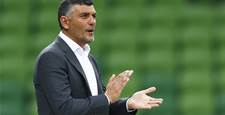Why is it that Australia breeds world class keepers like rabbits but can't create strikers?
Over the last 20-odd years we've been served by more than our fair share of excellent goalkeepers. There are three in particular (Bosnich, Kalac, Schwarzer) whose clubs and achievements put them in the highest echelon, but they couldn't have got to the top without being pushed hard by other keepers wanting their spots - at every level of the game since they were juniors.
Over the same period we have created one decent striker (Mark Viduka - I regard Cahill and Kewell as attacking midfielders) but even his greatest fans would hesitate to class Viduka in the very top tier. (If we define top tier as "would have been welcome at one of the G-14 clubs" then he probably makes it. No other Australian striker does.)
Why is it so?
Why can we make keepers but not strikers?
I have a theory.
For a start, the attributes and skills of keepers and strikers are very different. A keeper needs to have: height, agility, quick reflexes, courage. He/she needs to learn positioning, timing, strategy, communication and how to kick, catch or punch a ball.
A striker needs to have: pace, foot speed, excellent co-ordination, vision and a predatory instinct. He/she needs to learn positioning, timing, strategy, communication and how to trap, pass, dribble and shoot (with foot, head or any other available body part).
Is there something about these attributes and skills that gives Australians a leg up in one area but not the other? Superficially, you could point to the fact that Australia tends to have a higher proportion of tall men than most countries and that we enjoy social, economic and nutritional advantages that would help in the development of children into strong athletic adults, but this is equally true for keepers and strikers and if it really mattered, Australia would be a lot higher in the FIFA rankings than we are currently.
Therefore the answer must lie in the development of skills rather than the player's natural attributes. That suggests that the Australian football system is good at developing keeper skills but less good in developing striker skills.
This is where we get to my theory: the crossing of a football over a line is a terminal event - a moment of metaphorical death which is desperately avoided, by the goalkeeper in particular. Everything leading up to the terminal event of a goal is in flux - a continuous series of game transactions which are relatively calm in the middle of the pitch but are far more tightly and fiercely contested as you get closer to either goal. This means that the skill and strategy needed to score a goal (assuming that the teams are evenly matched) requires much more precision in the tight place of the box than is required elsewhere - especially as the key defender is allowed to use his hands!
Once the teams are already focussed on the box, with the defenders between the attackers and the goal, raw pace is less important (it's important for getting there first, but once you're there, in the furnace of the final third, less so). In the box it's speed of thought and foot that matter. A striker who is aware of others and their split-second runs is valuable. A striker who knows the exact moment to leave his marker and present for the ball is rare. A striker who can take three steps to a defender's two will always beat that defender if he can stay calm and use that skill when it matters. And a striker that can keep his head and get the best out of his touch, passing or shooting technique when a chance presents itself will go far.
In my opinion, striker skills are the hardest to learn and to perfect, which is probably why they get paid the most. Goals are hard to get and those who have the best goal getting skills are the most valuable players in the game. And at the top level, the difference between a good striker and a great striker is miniscule in terms of measurable skills but can be huge in terms of comparative statistics.
Okay, so if we understand what the striker skills are - why don't we breed good strikers?
The answer has to lie in junior development. A player improves as much as he needs to get to the next level. To use an analogy from the animal kingdom, if a lion wants to dine on a gazelle that can run at 50kph, the lion needs to run at 51kph. The lion might be capable of running at 60kph but if he grows up running at 51, that will become his limit and he'll go hungry when he meets a gazelle that can run at 52kph (or at 51 for longer). The same goes for strikers. Australian strikers may feast at the local junior level and then be selected for higher honours. The defenders they encounter at higher levels will stretch their capacity further and the ones who respond will again be selected to go higher - this is the escalator of junior football development (and big cat cuisine).
Traditionally in Australia, the talent has been spread too thinly to force young strikers to improve - to develop the finely tuned thoroughbred skills needed to prise open defences at a world class level. The only ones who come close are those who left for Europe when they were still young enough to go into an overseas development system (eg, Johnston, Viduka, Kewell, Cahill - and only one of these was a genuine striker).
But doesn't the same argument work for keepers and defenders? I hear you ask.
It probably does, but defenders have an advantage - they are already between the strikers and the goal and the closer the strikers get to the goal, the more tightly packed the defenders and the harder it is to get through them. In a game of such small margins, it is much easier for a defender/keeper to cope with a higher skilled striker, than for a striker to cope with a higher skilled defender. That's why tenacious Australia punches above its weight in defence but struggles to score against teams in the FIFA top 20.
At this point it is interesting to compare Australia with the US. If you look back over 20 years the Americans were also producing some top keepers (eg, Kasey Keller, Brad Friedel, Tim Howard) and no strikers, but all of a sudden their development system is coming good. First there was Brian McBride (more of an athlete than a footballer - but since then there's been Landon Donovan and now Buddle and Altidore. And these are players developed and playing in their home league! Okay - Altidore's now at Villareal but he went there as a 19 year old for US$10 million. Can you imagine anyone paying $10 million for an Australian 19 year old untested in a major league? It's an acknowledgment of the quality of their league as much as the individual.
Clearly, the American game has improved out of sight after hosting the World Cup and 16 years of the MLS. The potential of young players is being better developed so that by the time they reach their peaks the cutting edge skill of the strikers is starting to become noticeable on the world stage. There is an obvious message for Australia here.
But we're heading in the right direction. In my opinion the standard of the A-League is clearly improving (even though the best young players are still going overseas in their droves). The skill levels of the group coming through at 11 - 15 level is very high and the technical infrastructure for the most junior players (small sided games) is in place.
We need to ensure that the best are still being concentrated in elite competitions to force each other to develop higher level skills and we need to bring the World Cup to Australia. Inspire more of the top level junior athletes to play football (as opposed to other codes) and then we'll seriously be forcing the best to reach their best. We'll also have had 17 years of the A-League by 2022. Judging by the American (and the Japanese) experience, that sounds about right for the development of some home-grown world class strikers playing in our own domestic league, continuing to be challenged by even better defenders and keepers.
That's how to get the lions running at 60kph!
Adrian Deans is the author of Mr Cleansheets - published by Vulgar Press, distributed by Dennis Jones and Associates and available in all good book stores.












